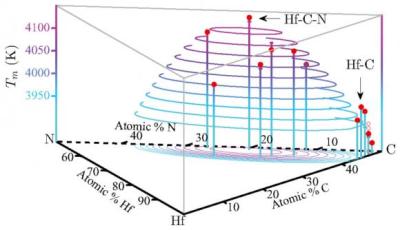Brown University researchers have used robust computer simulations to predict that a combination of hafnium, tantalum, and carbon (Hf-Ta-C) could result in a material with a very high melting point of over 4400K or 7460°F, which is two-thirds the sun’s surface temperature.
 Handling the heat -Compounds made from hafnium and carbon have some of the highest known melting points. Using computer simulations, Brown University engineers predict that a material made with hafnium, nitrogen, and carbon will have a higher melting point than any known material. (Image: Van de Walle lab/Brown University)
Handling the heat -Compounds made from hafnium and carbon have some of the highest known melting points. Using computer simulations, Brown University engineers predict that a material made with hafnium, nitrogen, and carbon will have a higher melting point than any known material. (Image: Van de Walle lab/Brown University)
This temperature is also 200K more than the highest melting point observed experimentally to date. The computations have been detailed in the journal Physical Review B (Rapid Communications). The computations indicate that the right composition of hafnium, nitrogen, and carbon — HfN0.38C0.51 holds promise for achieving this breakthrough. The researchers are now embarking on the next step that involves material synthesis and corroboration of the findings in the lab.
“The advantage of starting with the computational approach is we can try lots of different combinations very cheaply and find ones that might be worth experimenting with in the lab,” said Axel van de Walle, associate professor of engineering and co-author of the study with postdoctoral researcher Qijun Hong. “Otherwise we’d just be shooting in the dark. Now we know we have something that’s worth a try.”
The method employed by the researchers for computation infers melting points by simulation of physical processes at the atomic level, obeying quantum mechanics laws. The method studies melting dynamics as they take place at the nanoscale in blocks of 100 or so atoms.
Since there are a large number of potential compounds to be tested, the new method is challenging, though more effective when compared to conventional techniques. Brown’s “Oscar” high-performance computer cluster and XSEDE computer network from the National Science Foundation were used to perform the study.
Van de Walle and Hong performed the analysis of the Hf-Ta-C material, for which an experimental determination of the melting point had already been performed. Certain factors contributing to the excellent heat tolerance of the material could be explained by the simulation.
It was observed from the study that Hf-Ta-C is characterized by a high heat of fusion and a slight difference between the solid and liquid phase entropies. Heat of fusion is termed as the energy absorbed or released during solid to liquid phase transformation.
What makes something melt is the entropy gained in the process of phase transformation. So if the entropy of the solid is already very high, that tends to stabilize the solid and increase the melting point.
van de Walle
These findings were then used by the researchers for seeking compounds that may optimize those properties. They discovered that a compound made of hafnium, nitrogen, and carbon has exhibited a similar high heat of fusion but a very small difference between the solid and liquid entropies. When they determined the melting point with their technique, they found that the material’s melting point to be 200K more than the experimental record.
For compound synthesis and for performing melting point experiments, Van de Walle and Hong have now partnered with Alexandra Navrotsky’s lab at the University of California–Davis. Navrotksy’s lab has all the facilities required for such high-temperature experiments.
The work could ultimately point toward new high-performance materials for a variety of uses, from plating for gas turbines to heat shields on high-speed aircraft. But whether the HfN0.38C0.51 compound itself will be a useful material isn’t clear.
van de Walle
“Melting point isn’t the only property that’s important [in material applications],” he said. “You would need to consider things like mechanical properties and oxidation resistance and all sorts of other properties. So taking those things into account you may want to mix other things with this that might lower the melting point. But since you’re already starting so high, you have more leeway to adjust other properties. So I think this gives people an idea of what can be done.”
He also added that this study shows the power of this considerably new method. Recently, there has been a growing interest in the use of computations for exploring material properties of several candidate compounds. However, till now, studies have been focused on properties, which are more easier to calculate than the melting point.
“Melting point is a really difficult prediction problem compared to what has been done before,” van de Walle said. “For the modeling community, I think that’s what is special about this.”
The U.S. Office of Naval Research (N00014-12-1-0196 and N00014-14-1-0055) and Brown University, through the use of the facilities at its Center for Computation and Visualization, supported the research. The National Science Foundation Grant No. ACI-1053575 supports the Extreme Science and Engineering Discovery Environment (XSEDE), which was used in this work.
References